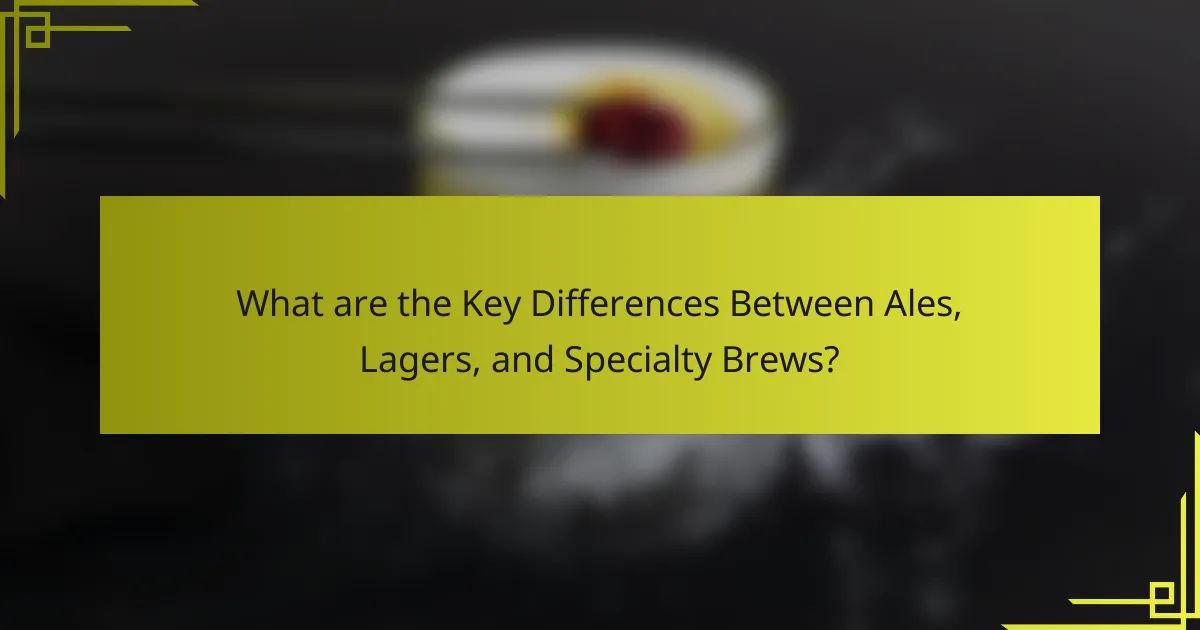Craft beer styles encompass a variety of beer categories produced by independent breweries, characterized by unique flavors, aromas, and brewing techniques. This article provides a comparative analysis of three primary craft beer styles: ales, lagers, and specialty brews. Ales are fermented at warmer temperatures using top-fermenting yeast, resulting in fruity profiles, while lagers utilize cooler fermentation with bottom-fermenting yeast for a clean taste. Specialty brews incorporate innovative ingredients and techniques, leading to diverse and distinct flavors. The discussion will also cover the specific fermentation processes, temperature ranges, and alcohol content associated with each style, highlighting the innovative nature of craft brewing.

What are Craft Beer Styles?
Craft beer styles refer to the diverse categories of beer produced by independent breweries using traditional and innovative brewing methods. These styles are characterized by unique flavors, aromas, and brewing techniques. Common craft beer styles include ales, lagers, stouts, porters, and IPAs. Each style has distinct characteristics influenced by ingredients like hops, malt, yeast, and water. For example, IPAs are known for their hoppy bitterness, while stouts are recognized for their rich, dark flavors. The Brewers Association defines craft beer as beer produced by small, independent breweries, emphasizing quality and creativity. This definition highlights the innovative nature of craft beer styles, which often push the boundaries of traditional brewing.
How do Ales differ from Lagers?
Ales differ from lagers primarily in their fermentation process. Ales undergo top fermentation, where yeast rises to the surface. This process typically occurs at warmer temperatures, around 60-75°F (15-24°C). Lagers, in contrast, use bottom fermentation, with yeast settling at the bottom. This occurs at cooler temperatures, generally between 45-55°F (7-13°C). The fermentation method affects flavor profiles. Ales tend to be fruity and complex, while lagers are often clean and crisp. The yeast strains used also differ significantly. Ale yeast is Saccharomyces cerevisiae, while lager yeast is Saccharomyces pastorianus. These differences in yeast and fermentation lead to distinct characteristics in aroma, taste, and appearance.
What are the primary characteristics of Ales?
Ales are a type of beer characterized by warm fermentation using top-fermenting yeast. This process typically occurs at temperatures between 60°F and 75°F. Ales often have a fruity and complex flavor profile. They can exhibit a wide range of colors, from pale gold to deep brown. The alcohol content in ales generally ranges from 4% to 8% ABV. Ales are known for their rich aromas, which can include notes of caramel, chocolate, and various fruits. The brewing process for ales usually involves shorter fermentation times compared to lagers. Historical evidence shows that ales have been brewed for thousands of years, making them one of the oldest beer styles.
What are the primary characteristics of Lagers?
Lagers are a type of beer characterized by bottom fermentation at cooler temperatures. This process typically occurs between 45°F to 55°F (7°C to 13°C). Lagers tend to have a clean, crisp taste with a smooth finish. They often exhibit a pale golden color, though they can also be amber or dark. The flavor profile is generally mild, with subtle hop bitterness and malt sweetness. Common lager styles include Pilsner, Helles, and Märzen. The fermentation process for lagers takes longer than for ales, often several weeks to months. This extended fermentation contributes to their clarity and smoothness.
What are Specialty Brews in Craft Beer?
Specialty brews in craft beer are unique and innovative beer styles created by brewers. These brews often incorporate unconventional ingredients or brewing techniques. They aim to provide distinct flavors, aromas, and experiences. Specialty brews can include fruit-infused beers, barrel-aged varieties, or those brewed with spices and herbs. According to the Brewers Association, specialty beers represent a growing segment of the craft beer market. They appeal to consumers seeking new and diverse tasting experiences. The emphasis on creativity sets specialty brews apart from traditional beer styles.
How do Specialty Brews differ from Ales and Lagers?
Specialty brews are distinct from ales and lagers primarily in their unique ingredients and brewing techniques. Ales and lagers are defined by their yeast types and fermentation temperatures. Ales use top-fermenting yeast at warmer temperatures, while lagers use bottom-fermenting yeast at cooler temperatures. Specialty brews often incorporate unconventional ingredients like fruits, spices, or herbs. This experimentation results in flavors and aromas not typically found in standard ales or lagers. Furthermore, specialty brews may utilize unique fermentation processes, such as barrel aging or wild yeast strains. These variations lead to a broader range of flavor profiles and styles in specialty brews compared to traditional ales and lagers.
What unique ingredients are often used in Specialty Brews?
Unique ingredients often used in specialty brews include exotic grains, fruits, spices, and herbs. Specialty brews frequently incorporate ingredients like coffee, chocolate, and honey to enhance flavor profiles. Some brewers use unique yeast strains to impart distinct characteristics. Ingredients such as chili peppers can add heat and complexity. For example, fruit-infused beers often feature berries or citrus for freshness. Additionally, brews may include seasonal ingredients like pumpkin or maple syrup. These unique components create diverse and innovative flavors in specialty brews.

What Brewing Techniques are Used for Different Beer Styles?
Different beer styles utilize distinct brewing techniques. Ales are typically fermented at warmer temperatures, promoting fruity esters. This technique involves top fermentation with yeast such as Saccharomyces cerevisiae. Lagers, in contrast, require cooler fermentation temperatures. They use bottom fermentation with yeast like Saccharomyces pastorianus. This method results in a clean, crisp taste. Specialty brews may employ unique techniques like barrel aging or dry hopping. Barrel aging adds complex flavors from wood. Dry hopping enhances aroma without affecting bitterness. Each technique is tailored to achieve specific flavor profiles and characteristics in the final product.
How does fermentation affect Ales and Lagers?
Fermentation significantly affects ales and lagers by determining their flavor profiles, aromas, and overall characteristics. Ales undergo top fermentation with yeast, typically at warmer temperatures, which produces fruity and complex flavors. This process usually takes place between 60°F to 75°F. In contrast, lagers utilize bottom fermentation with yeast at cooler temperatures, generally between 45°F to 55°F. This cooler fermentation leads to a cleaner and crisper taste profile.
The yeast strains used also differ; ales use Saccharomyces cerevisiae, while lagers employ Saccharomyces pastorianus. The fermentation duration varies as well, with ales fermenting faster, often within a week, while lagers require several weeks to months for a complete fermentation and conditioning process. This extended lagering period enhances the smoothness and clarity of the beer.
These fermentation differences are foundational to the distinct identities of ales and lagers in the craft beer landscape.
What fermentation temperatures are ideal for Ales?
The ideal fermentation temperatures for ales range from 60°F to 75°F (15°C to 24°C). This temperature range promotes the activity of ale yeast strains. Fermenting at lower temperatures can produce cleaner flavors. Higher temperatures may lead to increased esters and phenols. These compounds contribute to the fruity and spicy notes often found in ales. Yeast activity is optimal within this range, ensuring proper fermentation. Studies show that maintaining these temperatures yields consistent results in flavor and aroma.
What fermentation temperatures are ideal for Lagers?
The ideal fermentation temperatures for lagers range from 45°F to 55°F (7°C to 13°C). This temperature range promotes the clean and crisp characteristics typical of lagers. Fermenting at lower temperatures helps to minimize the production of esters and phenols. These byproducts can lead to off-flavors that are undesirable in lager styles. Yeast strains used for lagers, such as Saccharomyces pastorianus, thrive in these cooler conditions. Maintaining this temperature is crucial for achieving the desired flavor profile. Research indicates that fermentation at these temperatures results in a smoother and more refined beer.
What role do hops play in the brewing process?
Hops are a key ingredient in the brewing process. They contribute bitterness, aroma, and flavor to beer. The bitterness from hops balances the sweetness of the malt. This balance is crucial for the overall taste profile. Hops also contain essential oils that impart unique aromas. These aromas can range from floral to citrusy, depending on the hop variety. Additionally, hops have preservative qualities due to their antimicrobial properties. This helps extend the shelf life of the beer. The timing of hop addition during brewing affects the flavor and aroma profile. Early additions provide more bitterness, while later additions enhance aroma.
How do different hop varieties influence flavor in Ales?
Different hop varieties significantly influence the flavor profile of ales. Each hop type contributes unique aromatic and bittering characteristics. For example, Cascade hops impart citrus and floral notes. Citra hops are known for their tropical fruit flavors. Simcoe hops can add pine and earthy undertones. The timing of hop addition during brewing also affects flavor. Early additions enhance bitterness, while late additions boost aroma. Research indicates that hop oils play a crucial role in flavor complexity. Studies show that specific compounds in hops, such as myrcene and humulene, create distinct sensory experiences. Thus, the choice of hop variety is essential in crafting specific ale styles.
How do different hop varieties influence flavor in Lagers?
Different hop varieties significantly influence the flavor profile of lagers. Each hop variety contributes unique aromas and tastes. For example, Saaz hops impart a spicy, earthy flavor. Hallertau hops provide a floral and herbal character. Cascade hops add citrus and grapefruit notes. The timing of hop addition during brewing also affects flavor. Early additions enhance bitterness, while late additions boost aroma. This variability creates diverse lager styles. Studies show that hop selection is crucial for flavor development in lagers. Specific hop compounds interact with malt and yeast, shaping the overall taste experience.

What are the Key Differences Between Ales, Lagers, and Specialty Brews?
Ales, lagers, and specialty brews differ primarily in their fermentation processes. Ales ferment at warmer temperatures using top-fermenting yeast. This results in a fruity and complex flavor profile. Lagers, on the other hand, ferment at cooler temperatures with bottom-fermenting yeast. This leads to a cleaner and crisper taste. Specialty brews encompass unique ingredients or techniques, creating distinct flavors that don’t fit traditional categories.
The fermentation temperature for ales typically ranges from 60°F to 75°F. In contrast, lagers ferment between 45°F and 55°F. Ales often have higher alcohol content compared to lagers. Specialty brews can vary widely in both alcohol content and flavor due to their innovative ingredients. Each style reflects different brewing traditions and techniques, contributing to the diversity of craft beer.
How do flavor profiles vary among these beer styles?
Flavor profiles among beer styles vary significantly due to their ingredients and brewing techniques. Ales typically feature fruity and complex flavors, influenced by the use of top-fermenting yeast. Common ale flavors include citrus, banana, and caramel, stemming from higher fermentation temperatures. Lagers, on the other hand, present cleaner and crisper profiles. They utilize bottom-fermenting yeast and ferment at lower temperatures, resulting in flavors like bread, grain, and subtle hop bitterness. Specialty brews can encompass a wide range of flavors, often incorporating unique ingredients like spices, fruits, or wood aging, leading to diverse and innovative profiles. For example, a Belgian Tripel may exhibit fruity esters and spicy phenols, while a stout might showcase roasted coffee and chocolate notes. These differences in flavor profiles are a direct result of the yeast strains, fermentation temperatures, and additional ingredients used in each beer style.
What are the common flavor notes found in Ales?
Common flavor notes found in Ales include fruity, malty, and hoppy characteristics. Fruity notes often present in Ales can range from citrus to dark fruit flavors. Malty flavors typically provide sweetness and can include caramel and toffee notes. Hoppy characteristics contribute bitterness and can impart floral or piney aromas. These flavor profiles arise from the yeast and hops used in the brewing process. For example, ales fermented with specific yeast strains can enhance fruity esters. The balance of these notes varies significantly across different Ale styles, such as Pale Ales and IPAs. This diversity in flavor is a hallmark of Ales, making them distinct from other beer types.
What are the common flavor notes found in Lagers?
Lagers typically exhibit clean, crisp flavor notes. Common flavors include malty sweetness, often reminiscent of bread or biscuit. Some lagers present a light fruity aroma, such as apple or pear. Bitterness is generally low, with a smooth finish. Many lagers also have subtle herbal or floral hop characteristics. The fermentation process contributes to their clean taste profile. This is due to the use of bottom-fermenting yeast at cooler temperatures. Overall, lagers are known for their refreshing and balanced flavor experience.
What brewing methods are unique to Specialty Brews?
Specialty brews utilize unique brewing methods that set them apart from traditional beer styles. One method is barrel aging, where beer is stored in wooden barrels to develop complex flavors. Another method is dry hopping, which involves adding hops during fermentation for enhanced aroma. Specialty brews may also use adjuncts like fruits, spices, or herbs, introducing distinctive tastes. Additionally, some specialty brews employ unique fermentation techniques, such as wild fermentation, which uses wild yeast strains for a different flavor profile. These methods contribute to the creativity and diversity found in specialty brews.
What is the significance of barrel aging in Specialty Brews?
Barrel aging is significant in specialty brews because it enhances flavor complexity. The aging process allows the beer to absorb characteristics from the wood. This includes flavors from previous contents like whiskey or wine. The interaction with the wood also contributes to a smoother mouthfeel. Additionally, barrel aging can introduce tannins, which add depth. The process can also create unique aromas, such as vanilla or spice. Many craft brewers utilize specific barrels to achieve desired flavor profiles. Studies show that barrel aging can elevate the overall quality of the brew.
How does the use of adjuncts enhance Specialty Brews?
The use of adjuncts enhances specialty brews by adding unique flavors and textures. Adjuncts are ingredients beyond the traditional malt, hops, yeast, and water. They can include grains like corn or rice, fruits, spices, and even sugars. These ingredients contribute to the complexity of the brew’s profile. For example, using fruit adjuncts can impart sweetness and acidity. Spices can add warmth or herbal notes. Additionally, adjuncts can influence the mouthfeel and body of the beer. They allow brewers to experiment with seasonal and regional flavors. This versatility leads to a diverse range of specialty brews that appeal to various palates.
What are some best practices for brewing different beer styles?
Best practices for brewing different beer styles include understanding the specific requirements of each style. Ales typically ferment at warmer temperatures, around 60-75°F, while lagers require cooler fermentation at 45-55°F. Use appropriate yeast strains for each style; for example, ale yeast for ales and lager yeast for lagers. Adjust the grain bill to match the style; darker malts for stouts and lighter malts for pilsners. Pay attention to hop varieties; aromatic hops are crucial for IPAs, while noble hops are ideal for lagers. Control the fermentation time; ales usually ferment faster, while lagers benefit from longer conditioning periods. Monitor water chemistry, as different styles may require specific mineral profiles. Lastly, maintain cleanliness and sanitation throughout the brewing process to prevent contamination and ensure quality.
Craft beer styles encompass a variety of beer categories produced by independent breweries, characterized by unique flavors, aromas, and brewing techniques. This article provides a comparative analysis of ales, lagers, and specialty brews, detailing their fermentation processes, flavor profiles, and key characteristics. It explores the differences between ales and lagers, including fermentation temperatures and yeast types, as well as the innovative nature of specialty brews that incorporate unconventional ingredients and techniques. Additionally, the article discusses the role of hops in flavor development and best practices for brewing each style effectively.




